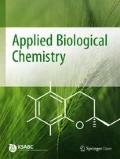Abstract
Persistence and degradation behaviors of acequinocyl and hydroxyacequinocyl were determined in perilla leaf grown under greenhouse conditions. Acequinocyl (15%, SC) was sprayed on perilla leaf at the recommended dose rate of 37.5 g/250 L water/10a with single and double dose applications. Leaf samples were collected randomly at 0 (2 h after application), 1, 3, 5, and 7 days post-application from two different plots. The samples were extracted with acetonitrile, purified through a solid phase extraction procedure, and analyzed via ultra performance liquid chromatography coupled with photo diode array detector (UPLCPDA). Residues were confirmed via liquid chromatography tandem mass spectrometry (LC-MS/MS) in positive-ion electrospray ionization (ESI+) mode. Calibration curves were linear over the concentration ranges for the analytes with r 2 ≥0.992. The limits of detection and quantification were 0.05 and 0.165 mg/kg for both acequinocyl and hydroxyacequinocyl. The method was validated in triplicate at two fortification concentrations in the matrix. Good recoveries were observed for the target analytes, ranging between 94.95 and 113.26% with relative standard deviations less than 6%. The rates of disappearance of total acequinocyl on perilla leaf for single and double doses were described as first-order kinetics with half-lives of 2.8 and 3.1-days, respectively.
Similar content being viewed by others
References
Businelli A, Vischetti C, and Coletti A (1992) Validation of Koc approach for modeling the fate of some herbicides in Italian soil. Fr Anal Chem 1, 583–588.
Caboni P, Sarais G. Melis M, Cabras M, and Cabras P (2004) Determination of Acequinocyl and Hydroxyacequinocyl on Fruits and Vegetables by HPLC-DAD. J Agric Food Chem 52, 6700–6702.
Cao Y, Chen J, Wang Y, Liang J, Chen L, and Lu Y (2005) HPLC/UV analysis of chlorfenapyr residues in cabbage and soil to study the dynamics of different formulations. Sci Total Environ 350, 38–46.
Causon R (1997) Validation of chromatographic methods in biomedical analysis. Viewpoint and discussion. J Chromatogr B 689, 175–180.
Clarke EE, Levy LS, Spurgeon A, and Calvert IA (1997) The problems associated with pesticide use by irrigation workers in Ghana. Occup Med 47, 301–308.
Dekeyser MA (2005) Acaricide mode of action. Pest Manag Sci 61, 103–110.
Freidberg S (2003) Cleaning up down South: supermarkets, ethical trade and African horticulture. Soc Cult Geog 4, 27–43.
Jerkovich AD, Mellors JS, and Jorgenson JW (2003) The use of micrometer-sized particles in ultrahigh pressure liquid chromatography. LC/GC North America 21, 60–61.
KFDA (2011) MRLs for Pesticides in Food. p 105, Korea Food and Drug Administration, Korea.
Kim SS and Yoo SS (2002) Comparative toxicity of some acaricides to the predatory mite, Phytoseiulus persimilis and the twospotted spider mite, Tetranychus urticae. BioControl 47, 563–573.
Kinoshita S, Koura Y, Kariya H, Ohsaki N, and Watanabe T (1999) AKD2023: A novel miticide. Biological activity and mode of action. Pestic Sci 55, 659–660.
Koura Y, Kinoshita S, Takasuka K, Koura S, Osaki N, Matsumoto et al. (1998) Respiratory Inhibition of Acaricide AKD2023 and Its Deacetylated Metabolite. J Pestic Sci 23, 18–21.
Osman KA, Al-Humaid AM, Al-Rehiayani SM, and Al-Redhaiman KN (2010) Monitoring of pesticide residues in vegetables marketed in Al-Qassim region, Saudi Arabia. Ecotoxical Environ Saf 73, 1433–1439.
Pretty J and Hine R (2005) Pesticide use and the environment. In the Pesticide Detox: towards a More Sustainable Agriculture. Pretty, J. (ed.), Earthscan, UK.
Putnam RA, Nelson JO, and Clark JM (2003) The Persistence and Degradation of Chlorothalonil and Chlorpyrifos in a Cranberry Bog. J Agric Food Chem 51, 170.
Author information
Authors and Affiliations
Corresponding author
Additional information
T. W. Na and M. M. Rahman contributed equally.
Rights and permissions
About this article
Cite this article
Na, T.W., Rahman, M.M., Park, JH. et al. Residual pattern of acequinocyl and hydroxyacequinocyl in perilla leaf grown under greenhouse conditions using ultra performance liquid chromatography-photo diode array detector with tandem mass confirmation. J Korean Soc Appl Biol Chem 55, 657–662 (2012). https://doi.org/10.1007/s13765-012-2101-x
Received:
Accepted:
Published:
Issue Date:
DOI: https://doi.org/10.1007/s13765-012-2101-x




